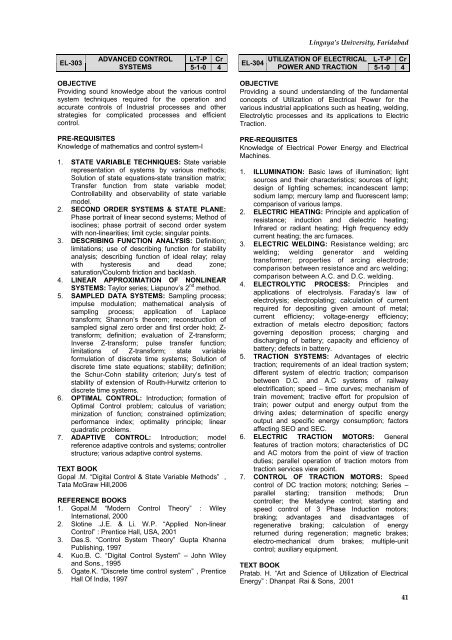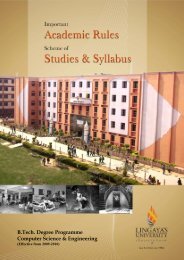B.Tech. Degree Programme Electrical Engineering - Lingaya's ...
B.Tech. Degree Programme Electrical Engineering - Lingaya's ...
B.Tech. Degree Programme Electrical Engineering - Lingaya's ...
You also want an ePaper? Increase the reach of your titles
YUMPU automatically turns print PDFs into web optimized ePapers that Google loves.
Lingaya’s University, FaridabadEL-303ADVANCED CONTROL L-T-P CrSYSTEMS 5-1-0 4EL-304UTILIZATION OF ELECTRICAL L-T-P CrPOWER AND TRACTION 5-1-0 4OBJECTIVEProviding sound knowledge about the various controlsystem techniques required for the operation andaccurate controls of Industrial processes and otherstrategies for complicated processes and efficientcontrol.PRE-REQUISITESKnowledge of mathematics and control system-I1. STATE VARIABLE TECHNIQUES: State variablerepresentation of systems by various methods;Solution of state equations-state transition matrix;Transfer function from state variable model;Controllability and observability of state variablemodel.2. SECOND ORDER SYSTEMS & STATE PLANE:Phase portrait of linear second systems; Method ofisoclines; phase portrait of second order systemwith non-linearities; limit cycle; singular points.3. DESCRIBING FUNCTION ANALYSIS: Definition;limitations; use of describing function for stabilityanalysis; describing function of ideal relay; relaywith hysteresis and dead zone;saturation/Coulomb friction and backlash.4. LINEAR APPROXIMATION OF NONLINEARSYSTEMS: Taylor series; Liapunov’s 2 nd method.5. SAMPLED DATA SYSTEMS: Sampling process;impulse modulation; mathematical analysis ofsampling process; application of Laplacetransform; Shannon’s theorem; reconstruction ofsampled signal zero order and first order hold; Z-transform; definition; evaluation of Z-transform;Inverse Z-transform; pulse transfer function;limitations of Z-transform; state variableformulation of discrete time systems; Solution ofdiscrete time state equations; stability; definition;the Schur-Cohn stability criterion; Jury’s test ofstability of extension of Routh-Hurwitz criterion todiscrete time systems.6. OPTIMAL CONTROL: Introduction; formation ofOptimal Control problem; calculus of variation;minization of function; constrained optimization;performance index; optimality principle; linearquadratic problems.7. ADAPTIVE CONTROL: Introduction; modelreference adaptive controls and systems; controllerstructure; various adaptive control systems.TEXT BOOKGopal .M. “Digital Control & State Variable Methods” ,Tata McGraw Hill,2006REFERENCE BOOKS1. Gopal.M “Modern Control Theory” : WileyInternational, 20002. Slotine .J.E. & Li. W.P. “Applied Non-linearControl” : Prentice Hall, USA, 20013. Das.S. “Control System Theory” Gupta KhannaPublishing, 19974. Kuo.B. C. “Digital Control System” – John Wileyand Sons., 19955. Ogate.K. “Discrete time control system” , PrenticeHall Of India, 1997OBJECTIVEProviding a sound understanding of the fundamentalconcepts of Utilization of <strong>Electrical</strong> Power for thevarious industrial applications such as heating, welding,Electrolytic processes and its applications to ElectricTraction.PRE-REQUISITESKnowledge of <strong>Electrical</strong> Power Energy and <strong>Electrical</strong>Machines.1. ILLUMINATION: Basic laws of illumination; lightsources and their characteristics; sources of light;design of lighting schemes; incandescent lamp;sodium lamp; mercury lamp and fluorescent lamp;comparison of various lamps.2. ELECTRIC HEATING: Principle and application ofresistance; induction and dielectric heating;Infrared or radiant heating; High frequency eddycurrent heating; the arc furnaces.3. ELECTRIC WELDING: Resistance welding; arcwelding; welding generator and weldingtransformer; properties of arcing electrode;comparison between resistance and arc welding;comparison between A.C. and D.C. welding.4. ELECTROLYTIC PROCESS: Principles andapplications of electrolysis. Faraday’s law ofelectrolysis; electroplating; calculation of currentrequired for depositing given amount of metal;current efficiency; voltage-energy efficiency;extraction of metals electro deposition; factorsgoverning deposition process; charging anddischarging of battery; capacity and efficiency ofbattery; defects in battery.5. TRACTION SYSTEMS: Advantages of electrictraction; requirements of an ideal traction system;different system of electric traction; comparisonbetween D.C. and A.C systems of railwayelectrification; speed – time curves; mechanism oftrain movement; tractive effort for propulsion oftrain; power output and energy output from thedriving axles; determination of specific energyoutput and specific energy consumption; factorsaffecting SEO and SEC.6. ELECTRIC TRACTION MOTORS: Generalfeatures of traction motors; characteristics of DCand AC motors from the point of view of tractionduties; parallel operation of traction motors fromtraction services view point.7. CONTROL OF TRACTION MOTORS: Speedcontrol of DC traction motors; notching; Series –parallel starting; transition methods; Druncontroller; the Metadyne control; starting andspeed control of 3 Phase Induction motors;braking; advantages and disadvantages ofregenerative braking; calculation of energyreturned during regeneration; magnetic brakes;electro-mechanical drum brakes; multiple-unitcontrol; auxiliary equipment.TEXT BOOKPratab. H. “Art and Science of Utilization of <strong>Electrical</strong>Energy” : Dhanpat Rai & Sons, 200141
















